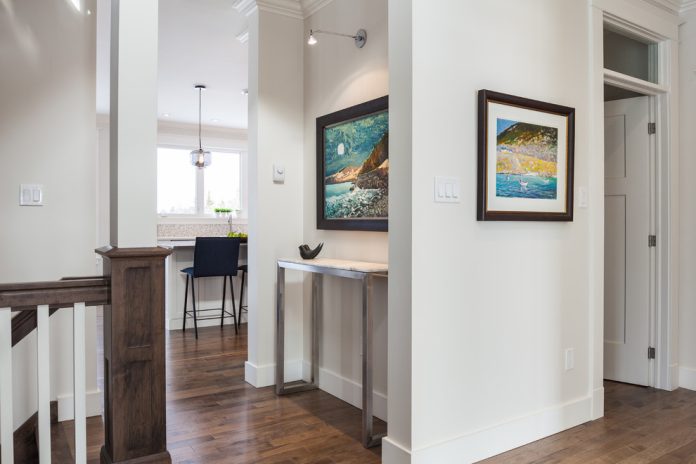Sales for hardwood and laminate flooring only continue to grow. In recent years, the hardwood flooring market rose to $3.49 billion, and laminate flooring rose to $988 million.
But which flooring is better for your home?
The answer: it depends.
Below we compare hardwood vs. laminate and give you all the information you need to know to decide which flooring will go in your home.
Best Appearance: Hardwood
When installing a new floor, how it looks is one of the most important factors for deciding what floor materials to use. If you want more options, you’ll go with hardwood.
Its natural texture full of unique organic grain patterns makes it one of the most beautiful flooring choices for homes. You can stain or finish it how you’d like to match any room.
Laminate’s wood grains look too uniform and unrealistic if you want to go for that hardwood look.
However, laminate still has many nice stylistic options that are improving in quality. If you’re willing to give up the hardwood look, you’ll be able to find a laminate pattern you like.
Best Installation Process: Laminate
Professional installation is the best way to go for flooring. Let’s take a look at what you can expect installation to look like.
Hardwood flooring installation times depend on the finish. Prefinished hardwood flooring can be completed quickly, while unfinished planks will need several days to finish and cure.
Laminate flooring can be installed below grade and over existing floors, making the process much easier. It comes refinished, so there’s no need for sanding or sealing. They’re also easier to DIY if you’re really in a crunch.
However, keep in mind that new installations of laminate have strong scents that take a few days to dissipate.
End your search for “flooring installation near me” by using professional services like Eagle Flooring West.
Best Durability: Hardwood
During the lifetime of your flooring, you can expect a few accidents to happen that will require repair. Scuffs from constant use, scratches from pets, or heavy objects may damage the flooring.
Both laminate and hardwood can be repaired, but hardwood is the winner here.
Laminate floors are inexpensive to repair but will stain easily. If there’s damage, a whole plank will need to be repaired. Scratches are much more visible.
Noticeable scratches can be reversed on hardwood floors, and they can be refinished many times based on your decor. And small scrapes or reclaimed planks add more life to the hardwood.
Most of the time, even damaged hardwood can be salvaged.
However, refinishing or repairing hardwood can be expensive. But it’s a small price to pay for a surface that has more character the more it’s used.
Best for a Budget: Laminate
Your budget and the size of the space will determine how much you can spend per foot.
Hardwood flooring is significantly more expensive than laminate: It will cost between $6 to $15 without installation. Exotic woods will cost more, and it costs extra to finish, treat, and wax the floor.
Laminate flooring costs about $2 or less per square foot without installation. Pricing is depending on the thickness of the laminate and its print layer’s quality.
Best for the Environment: Hardwood
Both laminate and hardwood flooring can be some of the best flooring choices for the planet.
Many laminate floors are recyclable, and laminate flooring is usually classified LEED-certified.
But hardwood takes the win here because it is a natural material that is biodegradable. It’s one of the few flooring choices that can be environmentally friendly, so long as it’s sourced sustainably.
Best for Bathrooms: Laminate
Laminate flooring is the better choice for bathrooms because it’s more able to withstand moisture. It also doesn’t need extra sealing and can be cleaned easily.
But even if you’re not installing laminate floors in your bathroom, they’ll still encounter moisture.
Hardwood can be water-resistant in some cases – the denser the wood, the more water-resistant. Regular care and finishing products can protect hardwood from water damage.
But untreated wood is likely to get moisture damage, and all wood needs regular sealing to maintain protection.
The top layer of laminate flooring is water-resistant and the material is less likely to develop mold. However, you should still watch out for standing water, as it can cause the top layer to bubble up.
Best for Resale: Hardwood
Adding new floors will boost the look of your home and will help with the resale value of your home in the short term, but hardwood is the best choice for the long term.
Laminate’s lower-cost means that it won’t add long-term value to your home. It only lasts about 25 years. If you live in your home for some time after you put in laminate, you may have to replace it again before listing it.
Hardwood can last generations. For many homeowners, older hardwood adds more character – you can expect the majority of homebuyers to invest more in a home with hardwood flooring.
Best for Pet Owners: Laminate
Pets and their sharp claws can damage the flooring. Laminate is best to withstand the lifestyle of a pet.
It’s more difficult for pets’ claws to scratch laminate. Laminate is more water-resistant, which is good for puppies and kittens who aren’t house trained yet. It also makes it easy to clean pet hair.
However, keep in mind that laminate may absorb the smell of pet waste if not cleaned quickly.
Meanwhile, only sealed and finished hardwood floors are resistant to water or waste from pets. Spills could cause moisture damage. And hardwood floors add a lot more noise to a household if a pet is running around or playing.
Choosing Hardwood vs. Laminate
When it comes down to choosing the flooring for your home, your lifestyle is the ultimate decision-maker for hardwood vs. laminate.
Both laminate and hardwood have numerous benefits, but hardwood is the winner if you want the most attractive flooring that will stand the test of time.
Learn more about home improvement and decor by viewing other blog posts on our website!










